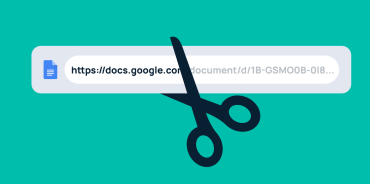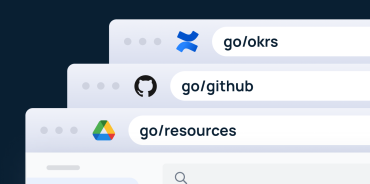Want to get started with go links?
Or wondering why this tool is so helpful?
We put together a comprehensive guide to walk you through everything there is to know about go links. Let’s dive in!
What are go links?
Go links, short for “go/links,” are customizable short links. They are designed to simplify and streamline how you navigate the digital landscape. Serving as shortened, easily memorable URLs, go links are convenient shortcuts to access specific web pages, documents, or resources.
These custom short links, starting with “go/” followed by a user-defined keyword, offer a user-friendly alternative to lengthy and complex URLs. Whether shared in emails, presentations, or casual conversations, they provide a concise and efficient means to direct users to specific online destinations.

For example, let’s say you’ve been working on a presentation in Google Slides. We all know Google links are long, and searching Google Drive for particular resources can be a pain. To easily access your presentation, you can shorten the link to go/presentation. This new link can be typed directly into your address bar to immediately direct you to the presentation.
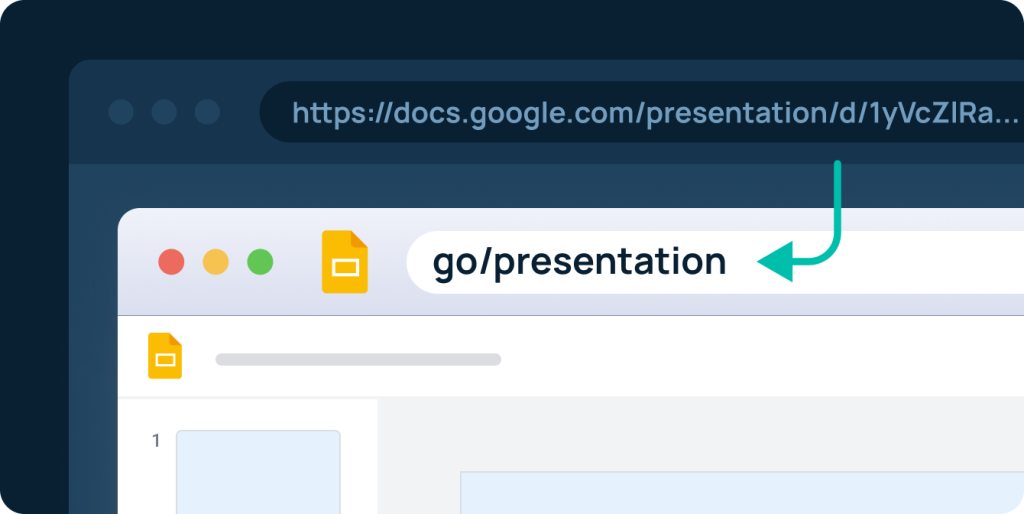
How do go links work?
Go links are pretty straightforward. You simply paste any link into the tool, and it allows you to create a shorter, more memorable version of the link.
The “magic” of them comes down to the redirect. Users type in or click the shortened link, which redirects them to the original long URL. That longer URL still exists, and the destination is the same; it just isn’t the address a user types in.
How are go links different from a URL shortener like Bitly? Here are some of the key differences:
Memorability
URL shorteners like Bitly may shorten links, but they don’t allow customization that makes them human-readable. The whole point of go links is that they are short, human-readable, and therefore, memorable. Rather than using randomly generated characters, you can use words like go/marketing-sync or go/sales-pitch. You can use whatever phrase you want after the “go” to create a link that can be remembered off the top of your head.
Internal usage
Tools like TinyURL are used to shorten URLs that are shared externally in emails or on social media. Anyone can access them. Go links, on the other hand, are used internally within organizations. They can only be accessed by employees, keeping company resources safe and secure.
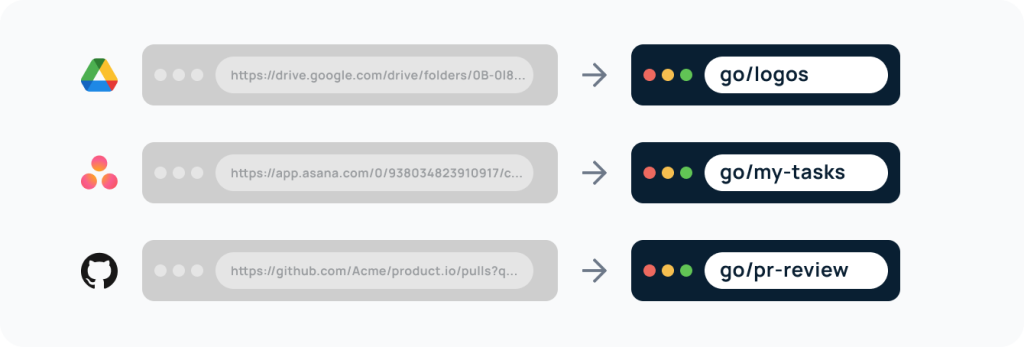
The history of go links
The go link, sometimes referred to as “go/link” or “go-link,” has existed since the early 2000s and is known as one of Silicon Valley’s biggest secrets since it’s used by companies like Google and Facebook. Let’s dive into the full history.
The invention of shorteners: TinyURL in 2002
The roots of link shorteners trace back to January 2002, when Kevin Gilbertson, a web developer, introduced the world to TinyURL. Designed to alleviate the burden of lengthy URLs in newsgroup postings, TinyURL emerged as the pioneer in URL shortening services. Its launch provided users with concise and easily shareable web addresses.
Google’s revolution: Short links in 2006
Fast forward to 2006. Eric DeFriez, an innovative engineer at Google, engineered the go link system, introducing the revolutionary “go/” domain. This system enabled Googlers to seamlessly use short links like “go/link” directly in their browsers. Benjamin Staffin, another Google engineer, likened golinks to “AOL keywords for the corporate network.” It swiftly became a cornerstone of the Google ecosystem, revolutionizing the way employees shared links within the company.
First documented history: NCSU in 2009
The first publicly documented history of go links emerged in November 2009, courtesy of Nick Young, an IT professional at North Carolina State University (NCSU). On October 10, 2010, the final version was unleashed upon NCSU, allowing the student body and faculty to create go links for easy sharing across classrooms, posters, emails, social media, and beyond.
Yo Links at Yahoo: A twist in 2012
In 2012, a similar golinks application surfaced at Yahoo, but with a distinctive moniker: “yo/links.” As tech professionals migrated from Google to various tech companies, they carried the significance of the go link application with them. This internal application soon became ubiquitous across Silicon Valley as engineers crafted similar systems, each with its unique touch.
The first SaaS tool: Jorge Zamora’s innovation in 2016
Inspired by the prevalence of go links during visits to tech companies, Jorge Zamora envisioned a more accessible and generalized solution – GoLinks as a Service. Observing the ubiquitous presence of “go/links” in cafeterias, break rooms, and hallways, Jorge recognized the potential for improvement and sought to make these short links available to the public. On August 29, 2016, he unveiled the first SaaS version of GoLinks
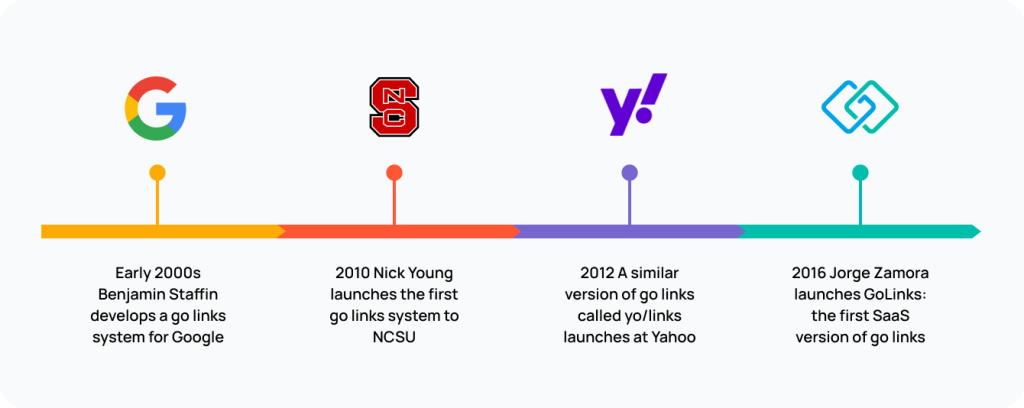
The benefits of go links
- Eliminate steps in finding and sharing information.
- Make knowledge sharing simple and intuitive so employees are less likely to duplicate work.
- Help teams share information across different platforms and channels.
- Empower employees to quickly find and share resources asynchronously.
- Help new employees intuitively find company resources.
- Preserve know-how so your company can keep projects moving forward.
- Allow employees to access company resources securely – no VPN needed.
- Achieve company-wide savings by boosting overall employee productivity.
Are go links free?
Yes – they are free! Though some platforms do cost money, GoLinks offers a free option; no credit card is required. Under the free account, your team can create unlimited links, set up the browser extension, integrate with Google Docs, and more.
Access and share resources instantly with GoLinks
Try for free
How to create go links
- Copy your URL: Begin by copying the URL you want to shorten directly from your browser’s address bar. This could be a long and intricate web address that you wish to simplify.
- Sign up for GoLinks: If you haven’t already, sign up for GoLinks to unlock the full potential of streamlined link management. Creating an account allows you to organize and customize your go links efficiently. Plus, you can sign up for free!
- Log into your GoLinks Dashboard: After signing up, log into your GoLinks account to access the dashboard where you can create, manage, and customize your go links.
- Initiate go link creation: Within your GoLinks dashboard, locate the “Create Go Link” button in the upper right corner. Click on this button to kickstart the process of crafting your personalized link.
- Paste your destination URL: In the prompted fields, paste the URL you copied earlier into the designated space. This step ensures that your go link seamlessly redirects users to the desired destination.
- Name your go link: Assign a meaningful and memorable name to your go link. This step personalizes the link and contributes to its accessibility and ease of use.
- Enhance with tags and description: Optionally, enrich your go link by adding tags and a brief description. Tags help categorize and organize your links, while a description provides additional context. This makes it easier for you to search and manage links within your dashboard.
- Click “Create Go Link”: Once you’re happy with your customization, click the “Create Go Link” button. This action finalizes the creation process, and you now have a concise, user-friendly link ready for sharing.
- Share with your team: Your newly created link is now ready to be shared with your team or collaborators. Copy and distribute it effortlessly!
How to use GoLinks
Once you have a GoLinks account, you can shorten any URL you want! We recommend you start by creating company-wide and team-specific links that lead to highly trafficked resources.
Here are some additional ways to start saving time with this tool:
Streamlined access to frequently used resources
Create go links for regularly accessed tools, internal documents, or shared folders, providing quick and direct access. For instance, “go/intranet” can lead directly to your company’s intranet portal.
Effortless URL sharing in communications
Simplify link sharing in emails, messages, and presentations by using go links. Instead of lengthy URLs, share concise and memorable links like “go/product-launch.”
Enhanced collaboration on documents
Improve collaboration on shared documents by creating go links to specific files or folders. For example, “go/project-docs” could lead directly to your project documentation.
Onboarding and training resources
Facilitate onboarding and training by creating go links to essential resources. “go/training-guide” could lead new employees to comprehensive training materials.
Event and meeting invitations
Embed go links in event invitations or meeting agendas. For instance, “go/monthly-meeting” can lead directly to the scheduled meeting details.
Customized department portals
Build customized departmental portals using go links. “go/marketing” could redirect to a page aggregating all marketing-related resources and tools.
Internal FAQs and helpdesk
Create go links for internal FAQs or helpdesk resources. “go/it-support” can lead directly to IT support documentation or contact details.
Employee handbook and policies
Direct employees to important documentation like handbooks or policies using go links. For instance, “go/handbook” could lead to the employee handbook.
Cross-platform integration
Seamlessly integrate go links into various platforms, including chat applications, to share information with team members conveniently. GoLinks integrates with Slack, for instance, so it’s easy to share resources in messages to coworkers.
Here are some more usage examples:
- go/hr — All HR resources
- go/it — Where to get support from IT
- go/401k — Retirement plan information and access
- go/weekly — Weekly team meeting access
- go/timeline — Product launch timeline
- go/sales — All sales resources or SalesForce
Go link FAQ
How secure are go links?
Go links are secured through various measures to ensure the safety of users’ access to company resources. These measures include encryption protocols and access control mechanisms that safeguard the integrity and confidentiality of the links.
Can I track the usage of my go links?
Yes, users can track the usage of their go links for analytics purposes. GoLinks provides tracking capabilities that allow users to monitor the performance and engagement of their links, providing valuable insights into link usage patterns.
Are there any limitations on the customization of go links?
While users have significant freedom in customizing go links, there may be certain limitations or guidelines to ensure consistency and usability across the organization. These limitations could include character limits, prohibited keywords, or other restrictions aimed at maintaining clarity and effectiveness in link creation.
Can go links be shared externally or are they restricted to internal use only?
Go links are primarily designed for internal use within organizations, ensuring secure access to company resources. However, GoLinks does offer a public go link setting that allows go links to be shareable with people outside of your company.
What happens if a go link destination changes?
In the event that the destination of a go link needs to be updated or changed, users can easily manage this through the GoLinks platform. They can edit the destination URL associated with the go link, ensuring that users are always directed to the correct resource, even if it undergoes changes over time.
How quickly do go links redirect users to their destinations?
Go links are designed to provide seamless and instantaneous redirection to their destinations, ensuring a smooth user experience. When users click on a go link, they are promptly redirected to the associated web page or resource without any noticeable delay, enhancing efficiency and productivity.
Does GoLinks offer integration with other tools or platforms?
Yes, GoLinks offers integration with various tools and platforms commonly used within organizations, such as Google Docs, Slack, and other productivity software. This integration enhances the usability and functionality of go links across different workflows and applications.
How to get started
Many Silicon Valley tech giants have their own internally developed version, but the reality is not all companies have the time or resources to do that.
Luckily, there’s another option. GoLinks is an affordable link shortening tool that offers sophisticated features you won’t get with an internally built system. Currently rated one of the top URL Shorteners on the market, GoLinks provides many features to help with productivity and knowledge management.
Ready to start using GoLinks? Sign up for free, or chat with our team to learn more.
Access and share resources instantly with GoLinks
Try for free

